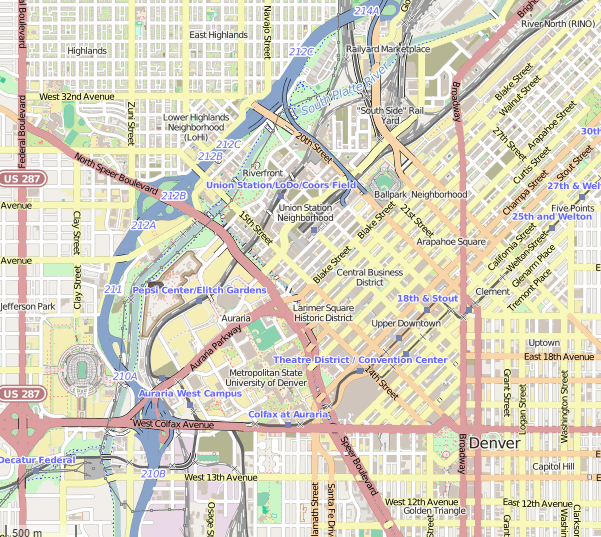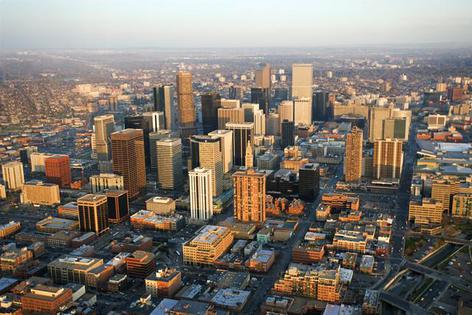Map: © OpenStreetMap contributors
Another Ed Sadowski creation
EDUCATION
Airports...Archaeology...Architecture...Art...Beer, Wine, Pubs... Bookstores...Bridges, Tunnels, Dams...Churches, Religion... Cities... Dinosaurs... Education...Events, Festivals...Food, Restaurants..Hotels... Libraries... Manufaturing...Health, Medicine...Mountains, Nature... Museums... Music...News media...People...Publishing...Races, Rallies, Parades...Radio, TV...Rail transit...Retail...Rivers, Lakes, Hot Springs...Sports...Stage, Screen...Streets, Highways, Infrastructure... Urbanism...Weather, Climate
Downtown
Denver
GONE INTO HISTORY
(gone entirely or moved from its original location)
Centre Theatre
Colfax-Larimer Viaduct
Emily Griffith Opportunity School (original location)
St. John's Cathedral (original location)
Tabor Grand Opera House
Windsor Hotel
Zeckendorf Plaza
Colfax-Larimer Viaduct ////////////////////////////////////////
GONE INTO HISTORY
When completed in 1917, the Colfax-Larimer Viaduct was the longest concrete span of its kind in the world: nearly a mile and a half of reinforced-concrete structure.
The Larimer viaduct connected the central business district to the railroad yards, while the longer Colfax viaduct, including a steel span over the South Platte River, reached west Denver. The viaduct consisted of a series of arches and cantilevers designed to handle the problematic expansion and contraction of the viaduct caused by heat and cold.
A forgotten part of Denver lay underneath the Colfax Viaduct—the "Bottoms," which from the late 1800s through the 1950s was home to cigar stores, bicycle shops, churches, grocery stores, hay markets and midwives. Eastern European Jews and Italians first lived there, followed by Mexican immigrants.
By the early 1980s, 35,000 vehicles crossed the viaduct daily, which was in need of repair. The original viaducts were demolished and replaced in 1983 by the present Colfax Viaduct and Auraria Parkway.
Emily Griffith Opportunity School ////////////////////////
13th and Welton
GONE INTO HISTORY (this location)
The Emily Griffith Opportunity School (now the Emily Griffith Technical College) was the world’s first free vocational school of its type for adults.
A tiny, mild-mannered teacher saw the need for adults to learn to read, write, and speak English, as well as to learn skills and trades in order to better their lives.
Before the turn of the century, Emily Griffith (1868–1947) organized evening classes in a Denver elementary school, but was overwhelmed by the demand. Griffith’s dream for a special school came true in 1916 when the Denver Public Schools converted the downtown Longfellow School into Opportunity School. The school was named after Griffith in 1933 when she retired.
This adult education center has grown to offer over 500 courses, having seen over 1.6 million students walk through its doors, offering an alternative high school program and community college curricula. In 1991, the school, now open to non-Denver residents, ceased being free due to a decline in funding, but tuition has been kept low. In 2014 the school moved to new locations, with its main campus at 1860 Lincoln Street.
St. John's Cathedral //////////////////////////////////////
20th & Welton
GONE INTO HISTORY (this location)
The Cathedral of St. John in the Wilderness was the US Episcopal Church’s first cathedral in the West, and the third Episcopal cathedral in the country.
It was built in 1881 at the corner of 20th and Welton streets. The Cathedral’s first dean was English-born H. Martyn Hart, who worked with other Denver clergy in 1887 to create the Denver Charity Organization, the first community charity solicitation fund in the United States, later renamed the United Way.
The Cathedral moved to its present Capitol Hill location at 14th and Washington streets, holding its first service there in 1911.
Tabor Grand Opera House //////////////////////////////
nw corner of 16th and Curtis
GONE INTO HISTORY
The Tabor Grand Opera House was said to be the most opulent building, the finest theatre between Chicago and San Francisco when it was built in 1881 by Horace Tabor for the then phenomenal sum of $850,000.
Tabor, the celebrated silver king who had amassed a fortune in Colorado’s mines (the most famous known as the Matchless), built an opera house in Leadville, then in Denver, bringing world-class culture to the new Queen City of the Plains. Tabor dabbled in politics and had many business ventures, and at his height was purportedly the fifth richest man in the country.
He scandalously married for the second time, to a much younger “Baby Doe,” their storied life together becoming the subject of an opera, movie, play and novel. The collapse of silver in the Panic of 1893 as well as risky investments wiped out Tabor’s fortune.
In 1921 the Opera House was extensively remodeled, becoming a movie palace. At this time the largest steel girder ever installed in a public building, was put into place to hold up the weight of most of the balcony. The theatre attracted the biggest names in entertainment as well as plays. Increasingly the theatre’s operation was not sustainable, and the building was torn down in 1964 during the urban renewal wave. The site is now occupied by the Denver branch of the Federal Reserve Bank of Kansas City.
Windsor Hotel ///////////////////////////////////////////////////////
nw corner 18th & Larimer
GONE INTO HISTORY
“The largest and most complete hotel between Chicago and San Francisco” was how the Windsor Hotel was touted when it opened in 1880.
The five-story Windsor was faced with lava stone with additions of sandstone and ironwork and modeled after England’s Windsor Castle and the Windsor Hotel in Montreal. The hotel was financed by an English syndicate, and flew the Stars and Stripes as well as the Union Jack and Windsor castle flags from its turrets.
Uncommon luxuries included hot and cold water and a spa with tile and marble, with Turkish, Russian and Roman baths fed by artesian wells. The hotel had its own farm with imported cows, and even its own hunters, who brought in wild game. The wine cellar was the best, stocked by bartender Harry Tammen, co-founder of The Denver Post. The hotel introduced the country’s first floating grand ballroom, made of white ash with black walnut, and suspended at each end by cables.
Guests of the Windsor included three presidents, Buffalo Bill Cody, Calamity Jane, Bat Masterson and Jack Kerouac. Silver king Horace Tabor housed his mistress Baby Doe there, then after losing his fortune and losing his mansion, he and wife Baby Doe lived there, where Tabor died.
Decades later the hotel became run-down and by the 1930s, the Windsor was labeled “the only flophouse in the world with a marble fireplace in every room.” Despite a restoration in the 1940s, the hotel eventually became run-down again. More restoration plans fell through and Denver’s first luxury hotel was demolished in 1960 to become a parking lot.
Zeckendorf Plaza
GONE INTO HISTORY
16th & Court Place
Superlatives: A renowned architectural example of a hyperbolic paraboloid roof, marking "an internationally-recognized marvel of corporate Modernism and a seminal American interpretation of the International Style."
You would have to comb the earth far and wide to find a hyperbolic paraboloid roof, but here was one, a magnificent one, on 16th Street. It was an iconic visual mark left by famed architect IM Pei that transformed Courthouse Square to Zeckendorf Plaza, Denver's answer to Rockefeller Plaza, complete with a skating rink.
The Plaza and the roof were the front part of a new May D&F Department Store in 1958. The roof was expansive and sharply angled, nearly touching the ground before diagonally soaring to a peak three stories high, topping the glass-walled entrance to the department store. It was an award-winning design described by Architecture Magazine as "an internationally-recognized marvel of corporate Modernism and a seminal American interpretation of the International Style."
Across Court Place, was the other part of the project, Denver's first high-rise hotel complex, the slab-shaped 22-story Hilton, casting its behemoth shadow over the airy Plaza. Downtown's out-migration of department stores caught up with the May D&F, and the large, proud department store was no more. The Hilton became Adam's Mark Hotel, which expanded into the main May D&F space. Then expansion plans eyed the destruction of the paraboloid. A preservation effort to grant landmark status to Zeckendorf Plaza failed, and the Plaza was demolished. In its place the hotel built what has been described as "a clunky black box" of a structure, with its interior a faux opulence gone out of style decades earlier. The 1200-plus room Adam's Mark became the Rocky Mountain West's largest hotel, and in 2008 was sold to Sheraton.



